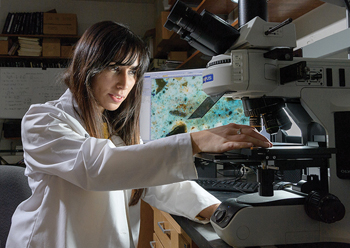New PCM process to keep homes cool
01 April 2023
Researchers at Purdue University in the US have developed a scalable, automatable process of incorporating phase change materials (PCMs) into construction materials used in building envelopes for thermal comfort and energy saving.
Mirian Velay-Lizancos, a Purdue University assistant professor of civil engineering from the Lyles School of Civil Engineering in the College of Engineering, and researchers in her laboratory have developed the patent-pending process that is said to improve the viability of incorporating PCMs into bricks, concrete panels and drywall, helping construction material manufacturers reduce energy consumption, as well as the carbon footprint of heating and cooling homes.
The incorporation of PCMs like paraffin, esters and salt hydrates into building envelope elements moderates the effect of outside temperature changes on the indoor environment. They convert changes in thermal energy into phase changes by transitioning from a solid into a liquid, or the opposite, thus providing useful cooling or heat by absorbing or releasing energy during those transitions.
“Incorporating PCMs reduces energy consumption in buildings, which reduces carbon dioxide emissions and operational costs,” Velay-Lizancos said. “It also decreases water permeability of construction materials.”
PCMs are used in a building’s envelope, or the doors, exterior walls, foundations, roofs, windows and other components that create a barrier between the indoors and the outdoors. The thermal properties of building envelopes play a key role in a building’s energy consumption.
“Increasing the thermal storage capabilities of building envelopes would reduce the effect of temperature fluctuations in a building,” Velay-Lizancos said. “This would increase the thermal comfort of the building and decrease energy consumption, carbon dioxide emissions and related economic costs of heating and cooling. It also would make buildings more resilient and energy independent and less susceptible to power outages and other energy supply issues.”
Velay-Lizancos said traditional methods to add PCMs in construction materials have drawbacks.
“Currently, PCMs are incorporated into other materials via microencapsulation or macroencapsulation,” she said. “However, these methods limit the use of PCMs. Microencapsulation has a negative effect on the strength and durability of construction materials. Macroencapsulation limits the shape and production method of construction materials.”
Velay-Lizancos’ method uses liquid immersion and a vacuum to incorporate PCMs after construction materials like bricks, drywall and concrete have already been formed.
“This increases the strength, enhances the durability and increases the thermal inertia of the construction materials,” she explained. “This new method also distributes PCMs so they are concentrated in the surface layer of the construction materials. More of the PCMs are in contact with external surfaces of the building envelope, which makes the PCMs more effective.”
Velay-Lizancos’ method requires only a vacuum system, which she said is very accessible and easy for manufacturers to work with.
“Users will need to be familiarised with the process, but they will not need special training,” she added. “The process could be easily automatised and incorporated into the production chain of precast elements like bricks, concrete panels, drywall and pavers, among others.”
Velay-Lizancos and her research group tested the innovation at the Pankow Laboratory in the Lyles School of Civil Engineering. The initial tests were conducted with commercial bricks and 15 minutes of vacuum time.
A large experimental campaign was conducted on cement mortars with three water-to-cement ratios and, therefore, different initial porosity levels. PCMs were incorporated into the mortars for three different vacuum periods: 15 minutes, one hour and four hours. Velay-Lizancos and her team observed an increase on the thermal inertia of 24 per cent and over a 22 per cent increase in the compressive strength, with just seven per cent of the volume of the element filled with PCM.
Velay-Lizancos said the uneven distribution of the PCM concentrated in the surface layer makes the PCM more effective in enhancing thermal properties.
“The method used in this study introduces the PCM into the layer of the material that is closer to the material's surface, meaning that more will be in contact with the external surfaces of the building envelope, resulting in more effective usage of the PCM,” she said. “Furthermore, this method pushes the PCM material into the capillary pores through the vacuum. Due to the capillary forces, leakage of PCM was not observed, even when the final composite was exposed to high temperatures well above the melting point of the PCM used.”
The next milestone to develop the PCM incorporation method is to build a full-scale prototype.
“This will allow us to visualise with cameras and sensors the thermal performance of the building envelope,” she said. “Clients will have the hard data and also be able to visualise the advantages of this technology.”
Velay-Lizancos disclosed the innovation to the Purdue Research Foundation Office of Technology Commercialization, which has applied for a patent on the intellectual property.
- Circular technologies the way forward
- JV aims for future of low-carbon concrete
- First DAC-to-concrete facility on way
- New PCM process to keep homes cool
- Vegetal concrete helps achieve green goals



